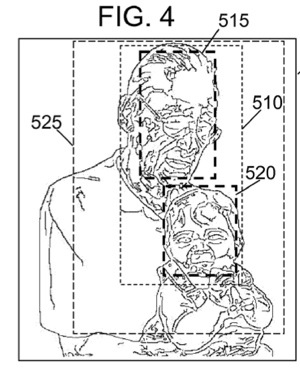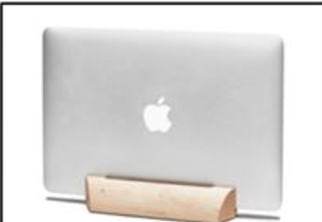Apple is already planned to beef up its Face recognition technology in iPhoto and perhaps iMovie, as indicated by a new patent (number 20110069085) at the US Patent & Trademark Office. The patent is for generating slideshows using facial detection information.
Methods and systems are presented for automatically generating a slide associated with a slideshow. In one aspect, a method includes selecting an image for inclusion in a slideshow, where the image has associated facial detection information. A face location is determined in the selected image based on the facial detection information and the selected image is cropped based on the determined face location to generate a cropped image depicting the included face. The cropped image is inserted into a slide associated with the slideshow.
Further, an animation having a defined animation path can be associated with the slide. Also, the face location can be identified as a position in the animation path and the slide can be animated based on the associated animation. The inventors are Raif Weber and Robert Van Osten.
Here’s Apple’s background and summary of the invention: “A slideshow is a popular format for presenting a collection of images alone or in conjunction with other information, such as text or audio. Slideshows have been used for a wide variety of purposes, including instruction, marketing, and entertainment. In some instances, the slideshow images are arranged sequentially or in accordance with image content to tell a story. Further, the pace of a slideshow can be controlled, whether the slides are advanced manually or automatically. For example, timing information can be associated with the slideshow to indicate when each slide is to be displayed.
“Previously, slideshows have been implemented using projectors and slide carousels. More recently, media presentation applications have been developed to assist users with slideshow development and customization for computer-based implementations. The applications can include templates that provide either or both of graphical material, e.g. theme elements, and structural material, e.g. timing information and transitions. Theme elements can be used to customize slide appearance, including color schemes and slide layout. Further, preset timings and transitions can be used to advance the slideshow from one slide to the next. In some implementations, the preset timings and transitions can be modified for one or more slides to control the amount of time a particular slide is displayed or the manner in which one slide replaces another in the show.
“Once a computer-based slideshow has been generated, the information associated with the slideshow, e.g. images and configuration data, can be stored to permit future retrieval. For instance, a generated slideshow can be stored on a Compact Disc (CD) or Digital Versatile Disc (DVD) as a presentation and accessed for playback on any compatible device. A slideshow also can be stored in an executable file, including in a streaming format, such that it can be accessed locally or over a communications network. Additionally, one or more rights management protections can be associated with a slideshow, such as to require a password to access the slideshow, to limit the period over which the slideshow can be accessed, or to limit one or more functions associated with the slideshow, including editing and printing slides.
”A slideshow can be automatically generated in accordance with facial detection information corresponding to one or more included images. For example, facial detection information associated with an image can be used to position the image within a slide or a slide template. Further, a portion of an image can be selected for use in a slide based on facial detection information that identifies the location of one or more faces in the image. Facial detection information also can be used to identify faces appearing in images that can be included or excluded from a slideshow.
“One or more images also can be selected for inclusion in a slideshow based on faces appearing in the images. For example, an individual can be identified as a subject of a slideshow and images in which the individual appears can be automatically selected for inclusion in the slideshow. Further, facial detection information can be used to organize slides within a slideshow. For example, images featuring one or more common individuals can be clustered such that they appear in the same slide or sequential slides.
“The present inventors recognized a need to use facial detection information associated with an image to determine the layout of a slide presenting that image. The need to crop an image, in accordance with facial detection information, to conform to a drop-zone included in a slide also was recognized. Further, the present inventors recognized the need to configure a slide such that one or more faces are visible during presentation of the slideshow.
“The present inventors also recognized the need to allow animating a slide based on facial detection information associated with an included image. For example, the need to automatically detect a dominant face as a subject of the animation was recognized. Also, the present inventors recognized the need to permit animating a slide based on an automatic determination of one or more popular faces, e.g. with respect to the slideshow or an image collection. Additionally, the present inventors recognized the need to permit suggesting a slideshow style based on facial detection information corresponding to the images included in the slideshow. Accordingly, the techniques and apparatus described here implement algorithms for automatically generating a slideshow based on facial detection information associated with one or more associated images.
“In general, in one aspect, the techniques can be implemented to include selecting an image for inclusion in a slideshow, the image having associated facial detection information, determining a face location in the selected image based on the facial detection information, cropping the selected image based on the determined face location to generate a cropped image depicting the included face, and inserting the cropped image into a slide associated with the slideshow.
“The techniques also can be implemented such that selecting an image further includes determining that the image corresponds to a subject of the slideshow. Further, the techniques can be implemented to include determining a slide layout based on dimensions corresponding to the cropped image. Additionally, the techniques can be implemented to include identifying a drop-zone included in the slide and associating the cropped image with the identified drop-zone.
“The techniques also can be implemented to include determining one or more drop-zone dimensions and generating the cropped image in accordance with the determined one or more drop-zone dimensions. Further, the techniques can be implemented such that cropping the selected image also includes defining a crop region such that the included face is positioned near a center of the cropped image. Additionally, the techniques can be implemented to include associating an animation with the slide, the animation having a defined animation path, identifying the face location as a position in the animation path, and animating the slide based on the associated animation.
“In general, in another aspect, the techniques can be implemented to include accessing a slide associated with a slideshow, determining an animation starting position associated with the slide, wherein the animation starting position is based on facial detection information, determining an animation ending position associated with the slide, and presenting a slide animation, in accordance with an animation path, from the animation starting position to the animation ending position.
“The techniques also can be implemented to include presenting a preceding slide associated with the slideshow, executing a transition from the preceding slide to the slide, and presenting the animation starting position associated with the slide. Further, the techniques can be implemented to include detecting an end of the slide animation and executing a transition from the slide to a succeeding slide. The techniques also can be implemented to include determining a starting crop associated with the slide, wherein the starting crop is based on facial detection information.
“Additionally, the techniques can be implemented such that the animation path includes a zoom with respect to a detected face location. Other implementations of this aspect include corresponding systems, apparatus, and computer programs, configured to perform the actions of the methods, encoded on computer storage devices.
“The techniques described in this specification can be implemented to realize one or more of the following advantages. For example, the techniques can be implemented such that one or more images can be positioned in a slideshow slide based, at least in part, on facial detection information. The one or more images can be positioned to keep included faces in the presentation. The techniques also can be implemented to permit cropping an image for use in a slideshow slide in accordance with facial detection information.
“Further, the facial detection information can be used to exclude one or more faces appearing in an image from use in the slideshow, such as using a size-based comparison. The techniques also can be implemented to organize images in one or more slides of a slideshow based on facial correlation information. Additionally, the techniques can be implemented to animate a slide in accordance with facial detection information, including information indicating whether a detected face is popular. The animation style used can be selected based on one or more previous slides that include animation.”
— Dennis Sellers



